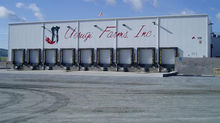Catch Weight

Catch Weight processing is a key requirement for Food Distribution companies. The costing and pricing of product by weight is essential to distributing many types of food items. While some users attempt to resolve this need by relying on average weights, this results in manual processes, lack of system controls, and extra steps and time spent receiving, tracking, and shipping product. ICS saw how vital this feature was to these company’s operations and decided to develop this capability for our Crescent Food Management suite. Since its development in 1995 this feature remains a core component of our Food Distribution and Manufacturing solutions in Crescent.
General Overview
The term catch weight comes from a concept of capturing the weight of an item at the time of shipping. The concept applies to items that are valued by weight and not eaches, dozens, cases, or other units of measure. In any environment where the client prices product by weight but doesn’t know the exact weight when taking the order, prices are calculated in the system by an averaging process. During the picking/shipping process, users must ‘catch’ the actual weight of the items. They weights are entered into the system during the invoicing process. Customers in the manufacturing, processing, and distribution market segments typically require this sort of process but usually don’t have a means of recording and tracking this information in a system. The typical work around is that inventory is tracked in cases or pieces, inventory valuation (in pounds) is tracked manually, and customer invoices showing weights are prepared by hand. In doing so, customers typically run into very large issues like unbalanced inventories or inaccurate sales quotes. This also imposes a big time burden, given all the extra steps, and corrective actions when mistakes are made due to a lack of system controls.
ICS designed its Catch Weight feature back in 1995 and remains the only Sage reseller to offer this feature to Sage 100 customers. With this functionality our company has helped many customers achieve the following benefits:
Accurately track inventory valuation while still being able to view the number of cases, pieces, or units that are actually in inventory
Accurately price merchandise to customers at the time of order
Provide customers precise billing by actual weight
How it Works
We find the Catch Weight feature is commonly used with items like cheeses and meets that fluctuate in weight. So for our example we will use a company who purchased a case of cheese that contains several wedges of cheese. Since the cheese is sold by weight, and the weight of each wedge is different, they will need to capture the weight of each specific wedge as it is being shipped out to a customer. The issue the company now faces is that they need a way to capture the exact weights at the point of shipping.
In this situation, the catch weight feature would allow the company to do the following:
Catch-weight items are designated with a Unit of Measure of LB (pounds) or KG (kilograms). This allows cost and price to be set accordingly.
The cheese company will take the order from their customer in Sales Order Entry where they will have the ability to check the number of cases of the item on hand in Item Quantity Inquiry (as seen in the image below – notice the Alt Qty On Hand, On PO, On SO, etc.).

After this, the total price will be automatically calculated based on the average weight. They will then use this estimate to provide their customer with an accurate sales quote (like the one shown below). Notice the entry of PCS Ordered (20) in the Alternate UOM (CASE), and the immediate conversion to estimated weight and pricing per pound (LB).

Once this item is ready to be shipped the warehouse worker, using the picking sheet, will go into Shipping Data Entry in Crescent and scan the exact weight of the pieces that were loaded on the truck. If scanning is not yet implemented, the exact weights can be recorded on the Picking Sheet.
The scanned items are then sent to the customer on the Packing List, allowing recipients to go through and match up all of the items they have.
After the item has been shipped this company would then create Invoices from Scans and send a final invoice to their customer.




















